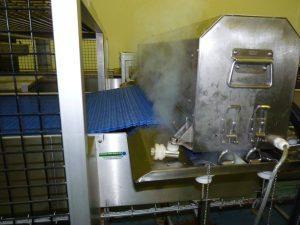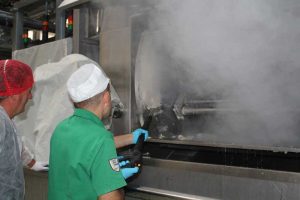Regular cleaning of conveyor belts is crucial for maintaining their performance and longevity. When conveyor belts become dirty or contaminated, they can experience increased friction, which can lead to excessive wear and tear. This not only shortens the lifespan of the belts but also reduces their efficiency and increases energy consumption.
Neglecting conveyor belt cleaning can have serious consequences. Contaminants on the belts can transfer onto the products being transported, leading to product contamination and potential health hazards. Additionally, build-up of debris on the belts can cause blockages or jams in the system, resulting in costly downtime for repairs.
Types of Conveyor Belt Cleaning Methods
There are several methods available for cleaning conveyor belts, ranging from manual to automated options. Manual methods include using brushes or scrapers to physically remove dirt and debris from the belts. While these methods can be effective for smaller systems or localized areas, they can be time-consuming and labor-intensive.
Automated methods for conveyor belt cleaning include the use of steam vapour cleaning machines. These machines use high-pressure steam to dissolve and remove dirt and contaminants from the belts. The steam is delivered through a nozzle or brush attachment, which can be manually operated or attached to an automated system.
Each method has its pros and cons. Manual methods are generally more affordable and can be effective for smaller systems. However, they require more time and effort to carry out. Automated methods, such as steam vapour cleaning machines, offer a more efficient and thorough cleaning process. They can cover larger areas in less time and provide a deeper clean. However, they may require a higher initial investment.
Advantages of Steam Vapour Cleaning Machines
Steam vapour cleaning machines have become a popular choice for conveyor belt cleaning due to their numerous advantages. One of the main benefits of using steam vapour is that it provides a chemical-free cleaning solution. The high-pressure steam is capable of dissolving and removing dirt, grease, and other contaminants without the need for harsh chemicals. This makes it a safer and more environmentally friendly option.
Another advantage of steam vapour cleaning machines is their versatility. They can be used on a wide range of conveyor belt materials, including rubber, PVC, and metal. This makes them suitable for various industries, such as food processing, manufacturing, and logistics.
Steam vapour cleaning machines also offer a faster and more efficient cleaning process compared to manual methods. The high-pressure steam can penetrate deep into the belts, effectively removing even stubborn dirt and grime. This results in a more thorough clean and reduces the need for repeated cleaning.
Components of Steam Vapour Cleaning Machines
| Advantages of Steam Vapour Cleaning Machines |
|---|
| 1. Chemical-free cleaning |
| 2. Kills bacteria and germs |
| 3. Removes tough stains and grime |
| 4. Saves time and effort |
| 5. Environmentally friendly |
| 6. Versatile cleaning capabilities |
| 7. Reduces allergens and dust mites |
| 8. Extends the life of surfaces and equipment |
Steam vapour cleaning machines consist of several components that work together to clean conveyor belts effectively. These components include a boiler or generator, a pressure vessel, a steam hose or wand, and various attachments such as nozzles or brushes.
The boiler or generator is responsible for heating water to produce steam. The pressure vessel stores the pressurized steam until it is released through the hose or wand. The attachments allow for different cleaning techniques, such as direct steam application or steam brushing.
The steam vapour cleaning machine may also include additional features, such as adjustable pressure settings, temperature control, and safety mechanisms. These features allow for customization and ensure safe and efficient operation.
How to Choose the Right Steam Vapour Cleaning Machine for Conveyor Belt Cleaning
When selecting a steam vapour cleaning machine for conveyor belt cleaning, there are several factors to consider. First, it is important to assess the size and complexity of the conveyor system. Larger systems may require more powerful machines or automated systems to ensure efficient cleaning.
The type of conveyor belt material should also be taken into account. Different materials may require different cleaning techniques or attachments. It is essential to choose a machine that is compatible with the specific belt material to avoid damage or ineffective cleaning.
Other factors to consider include the availability of spare parts and replacements, the reputation and reliability of the manufacturer, and any additional features or accessories that may be required for specific cleaning needs.
Benefits of Automatic Conveyor Belt Steam Vacuum

Automatic conveyor belt steam vacuum systems offer several advantages over manual methods or non-vacuum steam cleaning machines. These systems combine the power of steam vapour cleaning with a vacuum function, which allows for simultaneous cleaning and debris removal.
One of the main benefits of automatic conveyor belt steam vacuum systems is their efficiency. The combination of steam and vacuum ensures a thorough clean while minimizing downtime. The vacuum function removes dirt and debris as it is loosened by the steam, preventing it from settling back onto the belts.
Another advantage is the improved hygiene and safety provided by automatic systems. The vacuum function eliminates the need for manual removal of debris, reducing the risk of contamination or injury. This is especially important in industries where strict hygiene standards must be met, such as food processing or pharmaceuticals.
Maintenance and Troubleshooting of Steam Vapour Cleaning Machines
To ensure the optimal performance and longevity of steam vapour cleaning machines, regular maintenance is necessary. This includes routine cleaning of the machine, checking and replacing filters, and inspecting hoses and attachments for wear or damage.
It is also important to follow the manufacturer’s guidelines for maintenance and troubleshooting. This may include periodic descaling of the boiler or generator, lubrication of moving parts, and calibration of pressure and temperature settings.
Common issues that may arise with steam vapour cleaning machines include loss of pressure, water leaks, or malfunctioning attachments. These issues can often be resolved through simple troubleshooting steps, such as checking for blockages or adjusting settings. If more extensive repairs are needed, it is advisable to contact the manufacturer or a qualified technician.
Spare Parts and Replacements for Steam Vapour Cleaning Machines
Like any other machinery, steam vapour cleaning machines may require replacement parts or components over time. Common spare parts include hoses, brushes, nozzles, filters, and gaskets. These parts may wear out or become damaged with regular use and need to be replaced to ensure the continued performance of the machine.
Spare parts for steam vapour cleaning machines can usually be obtained from the manufacturer or authorized distributors. It is important to choose genuine parts to ensure compatibility and quality. Replacing parts should be done following the manufacturer’s instructions or with the assistance of a qualified technician if needed.
Maximizing Conveyor Belt Performance with Regular Cleaning and Maintenance
In conclusion, regular cleaning and maintenance are essential for maximizing the performance and longevity of conveyor belts. Neglecting this aspect can lead to reduced efficiency, increased wear and tear, and potential system breakdowns. Conveyor belt cleaning methods range from manual to automated options, with steam vapour cleaning machines being a popular choice due to their effectiveness and versatility.
Steam vapour cleaning machines offer numerous advantages over other methods, including chemical-free cleaning, versatility, and efficiency. They consist of several components that work together to provide a thorough clean, and selecting the right machine involves considering factors such as the size and complexity of the conveyor system and the type of belt material.
Automatic conveyor belt steam vacuum systems provide additional benefits, such as simultaneous cleaning and debris removal, improved hygiene, and safety. Regular maintenance and troubleshooting are necessary to keep steam vapour cleaning machines in optimal condition, and spare parts and replacements may be needed over time.
By prioritizing regular cleaning and maintenance, and utilizing the appropriate cleaning equipment, conveyor belt performance can be maximized, leading to increased efficiency, reduced downtime, and extended lifespan.
FAQs
What are conveyor belt cleaning systems?
Conveyor belt cleaning systems are devices used to clean conveyor belts in industrial settings. They are designed to remove debris, dirt, and other contaminants from the surface of the belt to ensure it runs smoothly and efficiently.
What are spare parts for conveyor belt cleaning systems?
Spare parts for conveyor belt cleaning systems are replacement components that can be used to repair or replace damaged or worn-out parts of the system. These parts may include brushes, scrapers, blades, bearings, and other components.
Why are spare parts important for conveyor belt cleaning systems?
Spare parts are important for conveyor belt cleaning systems because they help to ensure that the system continues to function properly. By replacing damaged or worn-out parts, the system can be maintained at peak performance, reducing downtime and increasing productivity.
What types of spare parts are available for conveyor belt cleaning systems?
There are many types of spare parts available for conveyor belt cleaning systems, including brushes, scrapers, blades, bearings, and other components. These parts may be made from a variety of materials, including rubber, polyurethane, and steel.
Where can I find spare parts for my conveyor belt cleaning system?
Spare parts for conveyor belt cleaning systems can be found from a variety of sources, including manufacturers, distributors, and online retailers. It is important to ensure that the parts you purchase are compatible with your specific system to ensure proper function.
How often should I replace spare parts for my conveyor belt cleaning system?
The frequency with which spare parts should be replaced will depend on a variety of factors, including the type of system, the amount of use, and the environment in which it is used. It is important to follow the manufacturer’s recommendations for maintenance and replacement to ensure optimal performance.










